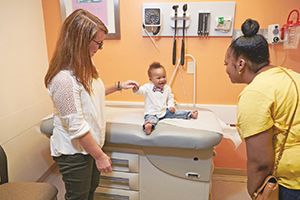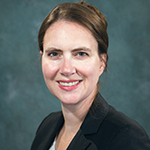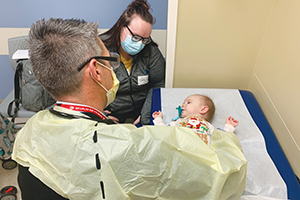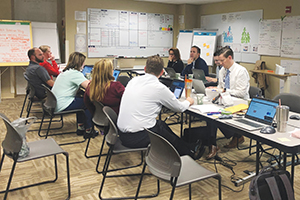Collaborators seek to grow the number of hospitals capable of caring for children in disasters
By LISA EISENHAUER
SSM Health Cardinal Glennon Children's Hospital in St. Louis has a major role in a new national network to improve and standardize the care of children, especially in disasters.

Beth Rhyne, a pediatric nurse practitioner, examines Jamierson Montgomery as he smiles at his mother, Jamie Montgomery, at SSM Health Cardinal Glennon Children’s Hospital in St. Louis. The hospital is one of the hubs for the newly created Regional Pediatric Pandemic Network, a national effort to expand the number of hospitals capable of caring for children in disasters.
SSM Health Cardinal Glennon Children’s Hospital
Cardinal Glennon is one of the five hub hospitals in the Regional Pediatric Pandemic Network. The Health Resources and Services Administration, part of the U.S. Department of Health and Human Services, established the network this summer and granted $48 million to cover operations for five years.
The other hubs are University Hospitals Rainbow Babies and Children's Hospital in Cleveland, UCSF Benioff Children's Hospital in San Francisco, Norton Children's hospital in Louisville, Kentucky, and Primary Children's Hospital in Salt Lake City. Primary Children's is part of Intermountain Healthcare, which is the process of merging with SCL Health.
All of the hospitals are affiliated with universities, a requirement to take a lead role. Cardinal Glennon is affiliated with the Saint Louis University School of Medicine.

Charney
Dr. Rachel Charney, an emergency medicine pediatrician who is in charge of emergency and disaster preparedness at Cardinal Glennon, is a primary investigator for the pediatric network. She will lead the hospital's effort to create a pediatric disaster preparedness plan for the Midwest. The plan will include collaborations among hospitals and partnerships with other agencies that respond to disasters.
Charney says the plan will build on research she has done and practices she has developed in her work at Cardinal Glennon and as a professor of pediatrics at Saint Louis University School of Medicine.
"What tends to happen a lot in disaster preparedness is we function in silos," Charney says. "One pediatric hospital may be developing reunification plans (to reunite unaccompanied children and their families), for instance, and another pediatric hospital is independently creating plans to do the same thing, but we often don't have a process in place to really communicate that, so we're duplicating efforts."
Sharing knowledge, practices
Charney defines a disaster as basically any event that overwhelms the resources of the area where it's occurring. That can include a school bus crash with more casualties than a nearby hospital can accommodate, an environmental catastrophe in a region that lacks expertise and hazardous materials remediation equipment to respond or a mass shooting where victims are transported to multiple hospitals for trauma or emergency care.

Ashley Obrock-Mayer watches as Dr. Michael Smiley, a pulmonologist at SSM Health Cardinal Glennon Children's Hospital, examines her son, Grayson. The hospital is one of five across the nation designated as a hub of the new Regional Pediatric Pandemic Network. Their charge is to improve care for young patients at hospitals nationwide.
SSM Health Cardinal Glennon Children's Hospital
"When we look at disasters we try and do it through what's called an all-hazards approach, so looking at what can we apply to any scenario and then more specifically what do we need to do for earthquakes, hurricanes, tornadoes," Charney says.
The hub hospitals will focus on specific areas, called domains, in creating best practices and sharing learnings. Those domains include communications, equity, trauma, advocacy, telehealth and infectious disease. A domain of particular interest to Charney, a mother of three, is reunification of children with their families.
"We know that the faster we're able to reunify kids the better the outcome is for them, both emotionally as well as physically because then we understand their medical history," she says.
Prehospital is another domain and in that one Charney says Cardinal Glennon will share its Special Needs Tracking and Awareness Response System, known as STARS, as a best practice. The program, led by paramedic Patricia Casey, provides individualized training to hospitals and first responders in more than 30 counties so they can better care for children living in their district who have complex medical conditions, such as home ventilator dependence, congenital heart disease or severe neurological disorders.

The SSM Health Cardinal Glennon Children's Hospital Incident Command team meets to collaborate on concerns related to the COVID-19 pandemic. As one of five hubs for the Regional Pediatric Pandemic Network, the St. Louis hospital will share best practices related to pediatric care in disasters.
Help for all hospitals
The Regional Pediatric Pandemic Network charge extends well beyond keeping children safe when an illness is rampant, says Dr. Charles G. Macias. He is leading the network in his capacity as chief of pediatric emergency medicine and chief quality officer at UH Rainbow.
"The intent of all of this work is to really grow the number of hospitals that are capable of taking care of children in emergencies, in urgencies, in everyday needs, in the midst of global health threats," he says.
Macias says the hub hospitals were selected because of the depth of their staffs' expertise and because they are in regions of the country in need of better coordination and sharing of best practices and resources to improve pediatric care.
The network will build upon the work of the Eastern Great Lakes Pediatric Consortium for Disaster Response led by UH Rainbow and the Western Region Alliance for Pediatric Emergency Management led by UCSF Benioff Children's.
Those two programs were set up as pilots in 2019 through a federal grant. Their mission, as stated in the funding announcement, is now the mission of the larger network: "define the delivery of pediatric clinical care when existing systems are stressed or overwhelmed by enhancing rapid sharing of expertise and assets."
Filling the COVID gaps
Macias says that while the regional pilot programs came before the COVID-19 pandemic, the gaps in preparedness spotlighted by that crisis have made clear the need for better coordination in the pediatric health sector and will inform the work of the larger network. For example, many hospitals had to develop their own guidelines for COVID care for children. Had the network been in place, it could have developed and shared those guidelines.
"As you think about all the learning that was having to happen on the fly or individually, or investments that had to be created for their own institutions, wouldn't it have been lovely if all of that was consolidated and being done in a national network so that we simply went to that source and didn't have to generate it?" he says.
Once the network is sharing practices and coordinating efforts, Charney expects it to raise the standard of care for children across the country.
"I think this grant is going to give us the resources we need to really see visible change in how we protect our children in disasters," she says. "As both a pediatrician and disaster expert, and as a mom, I find that really exciting."